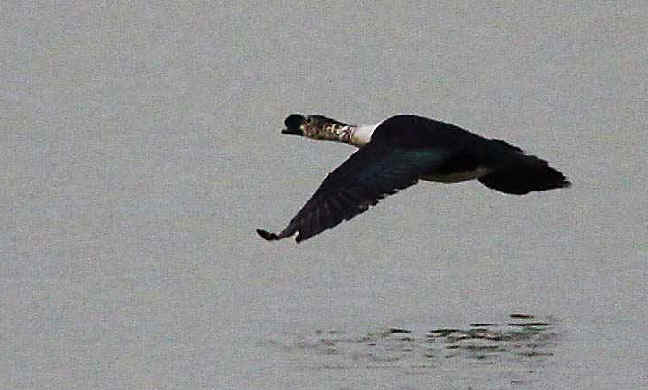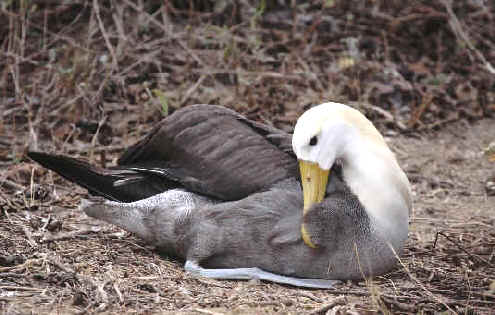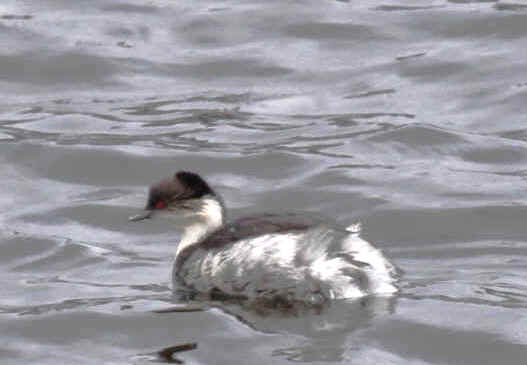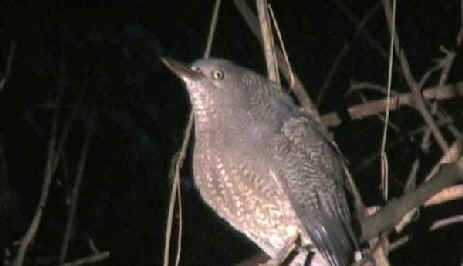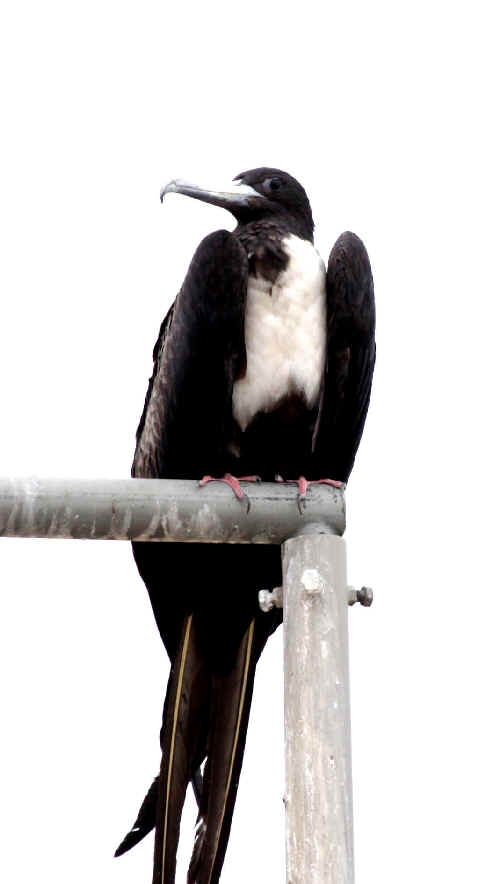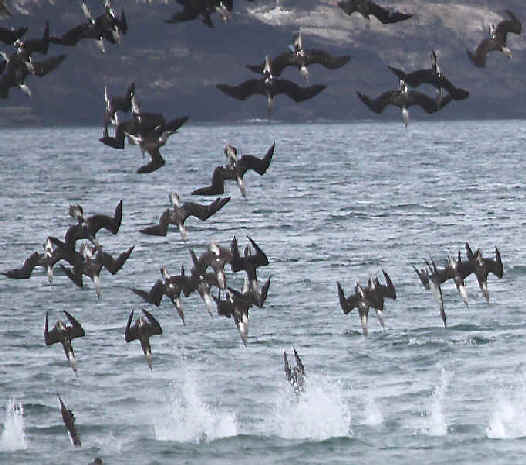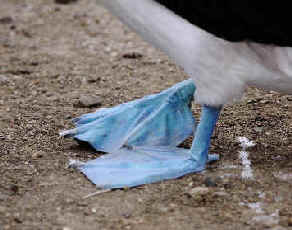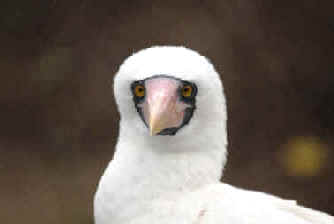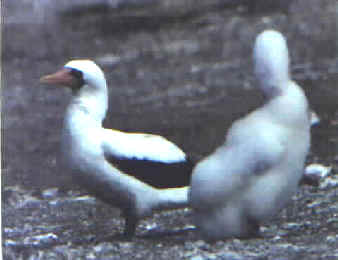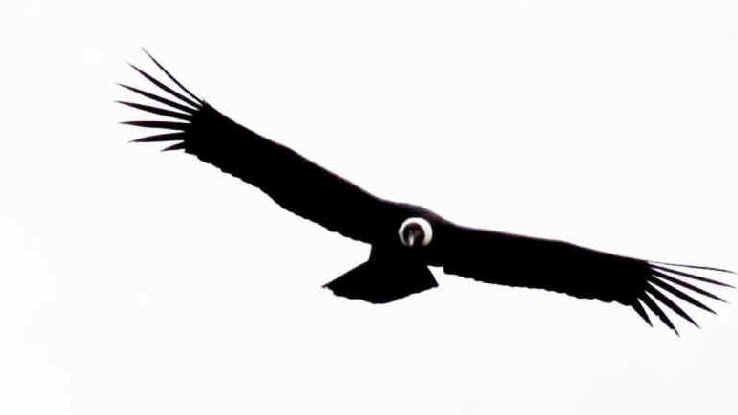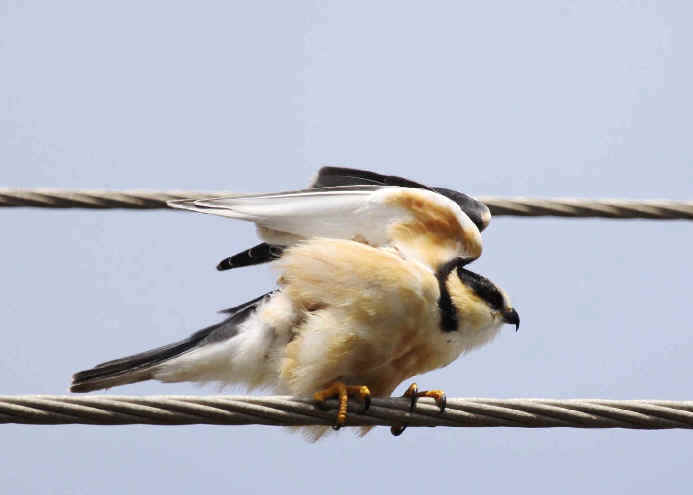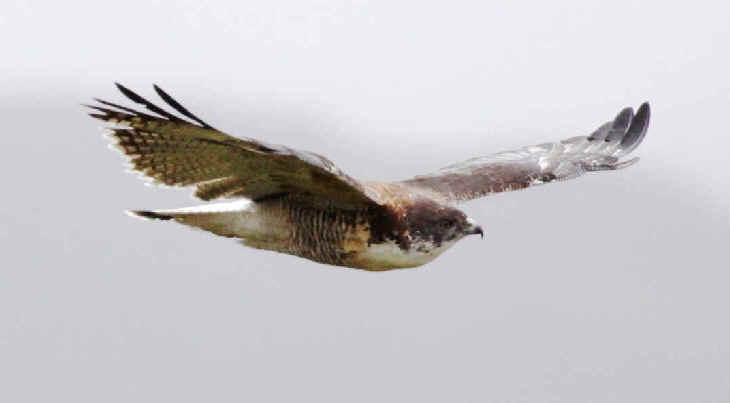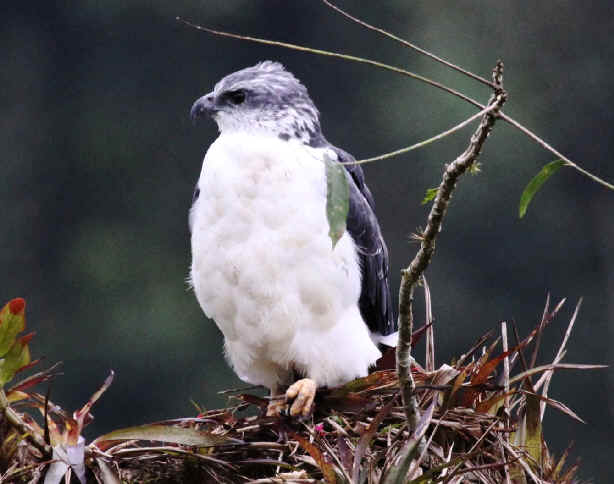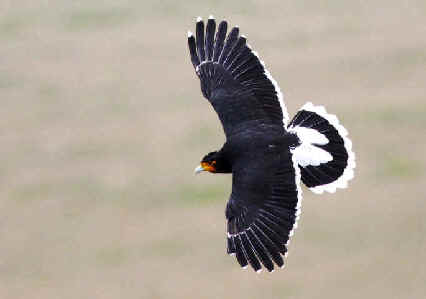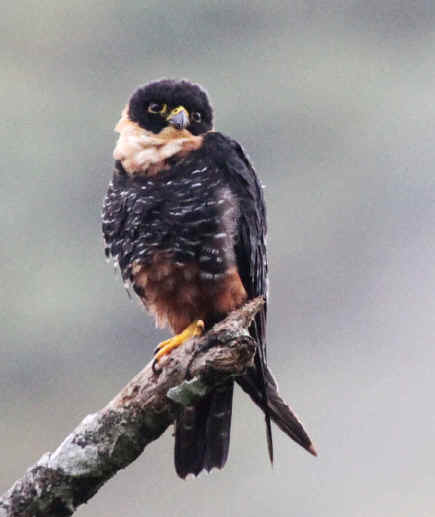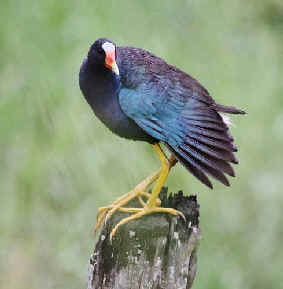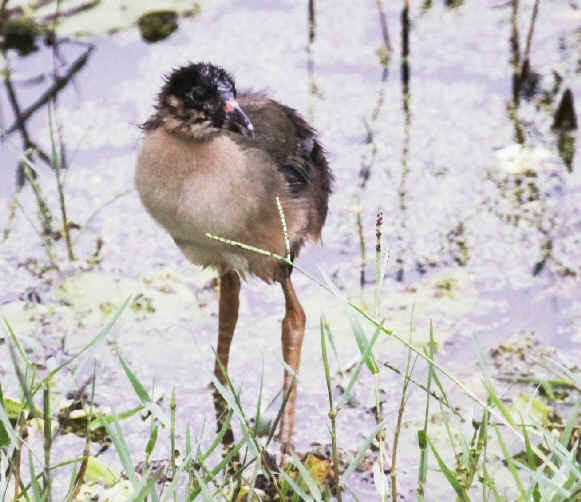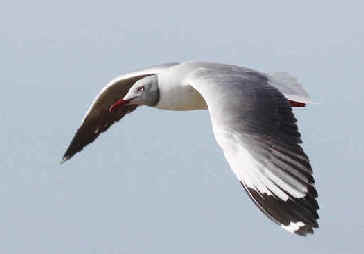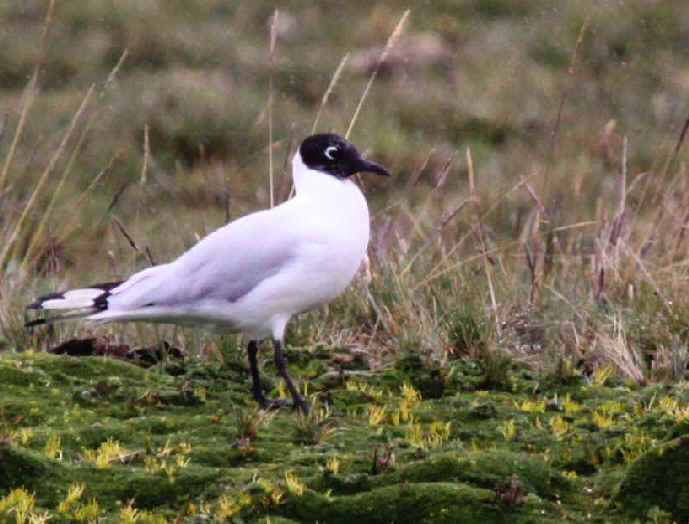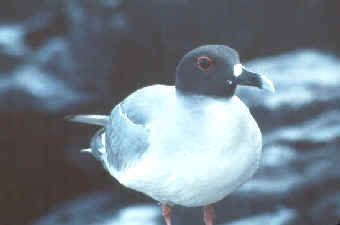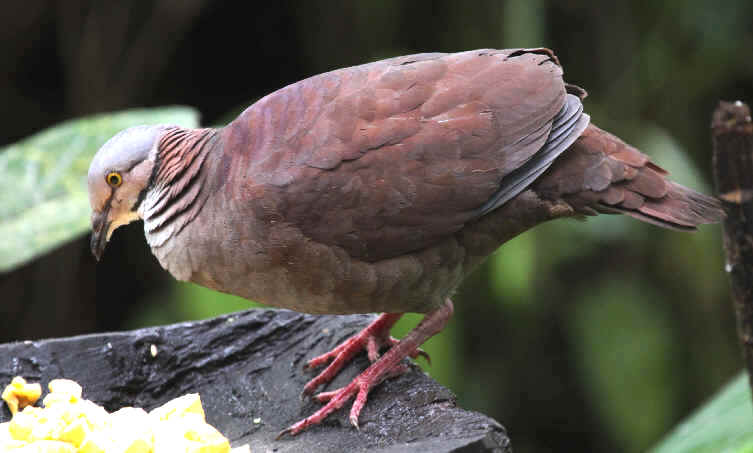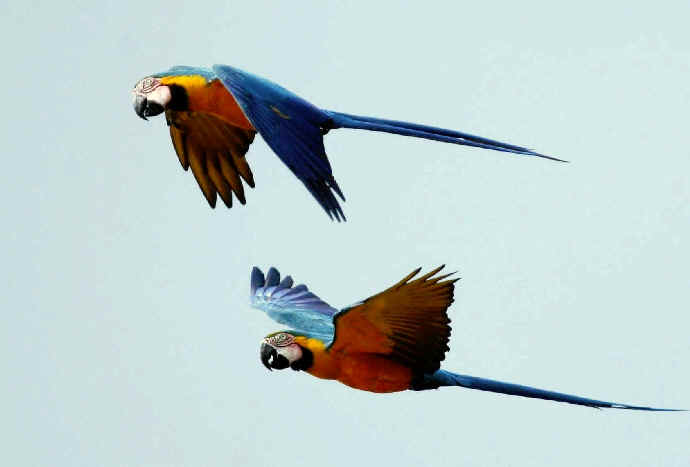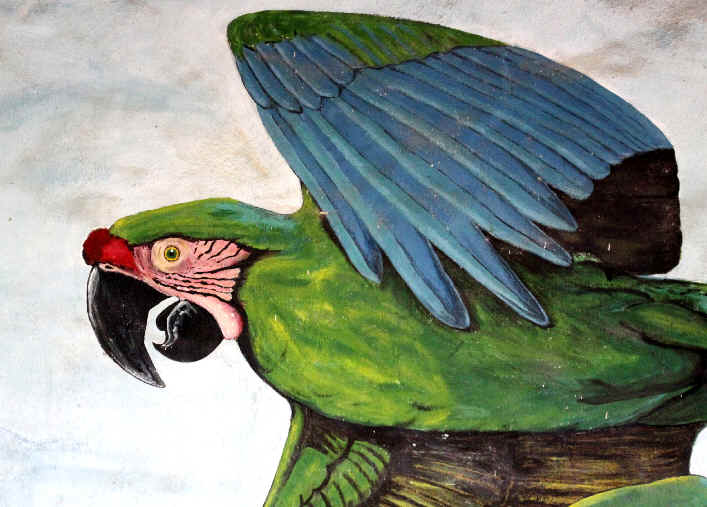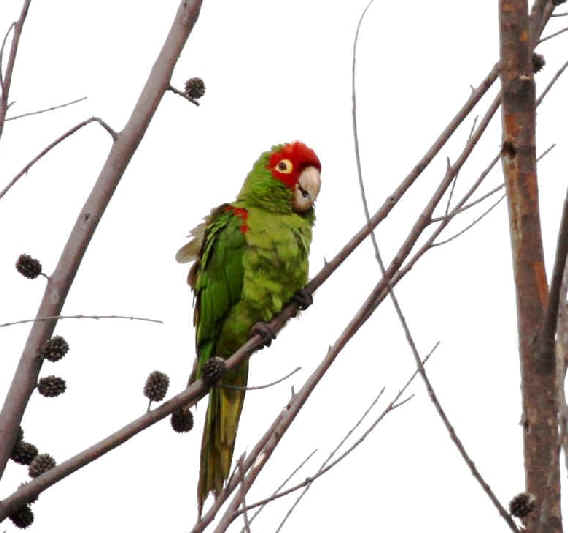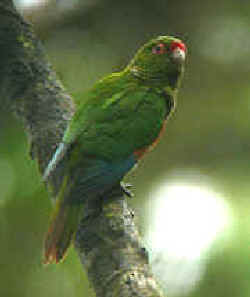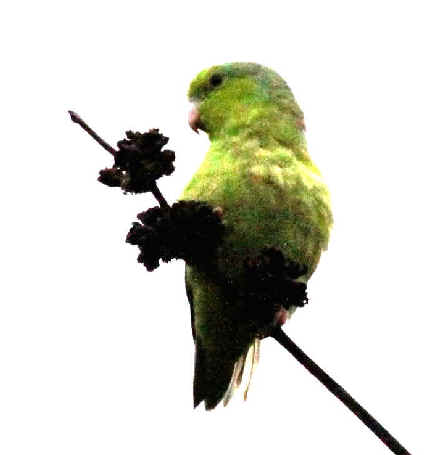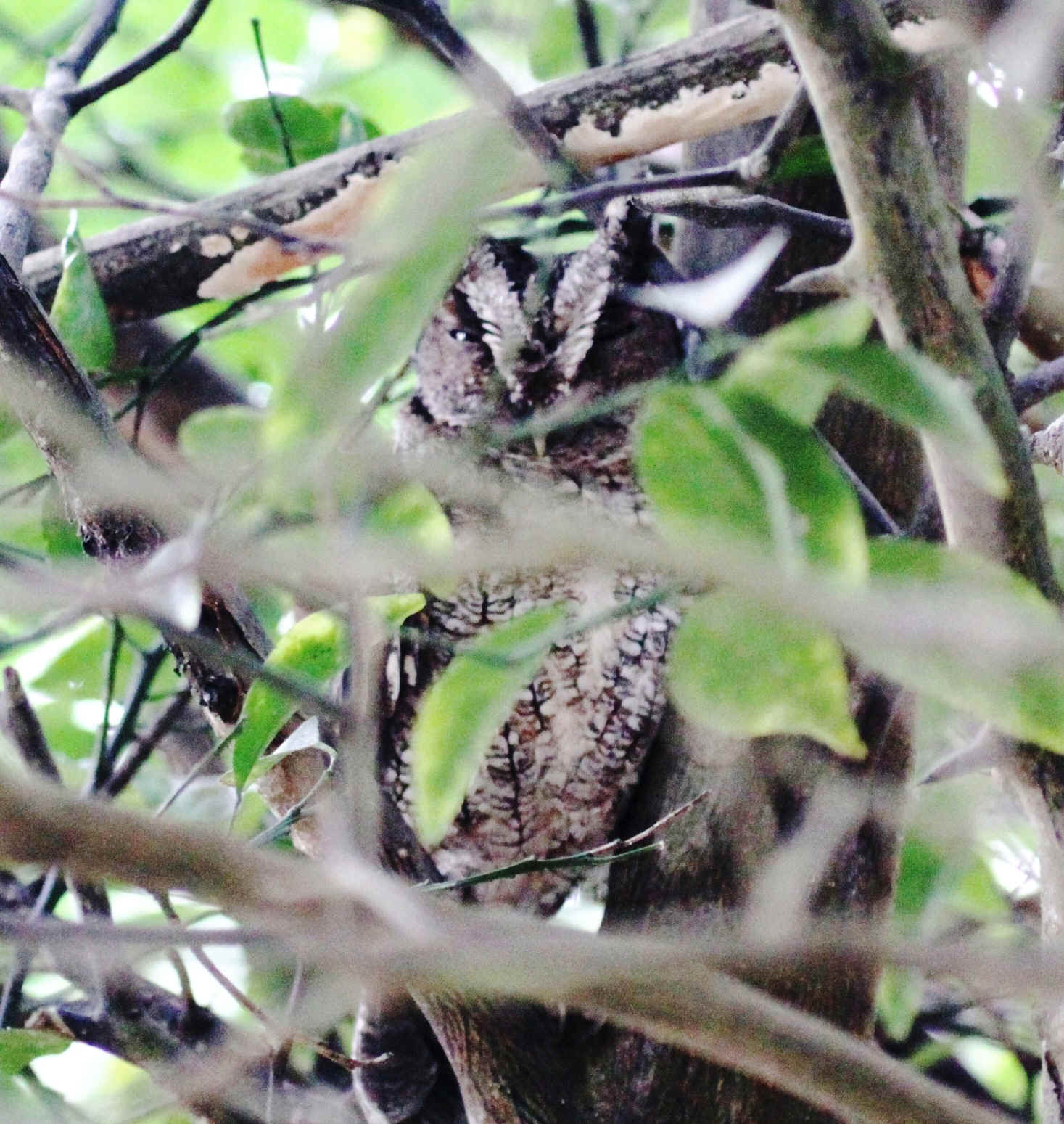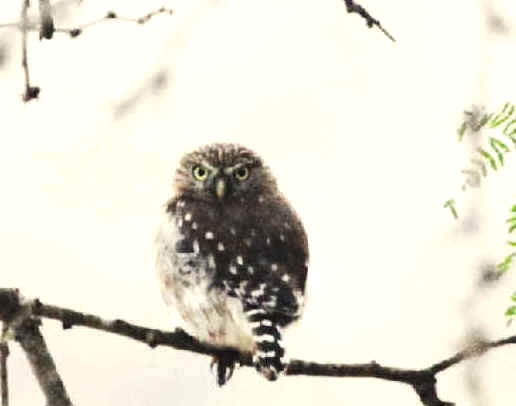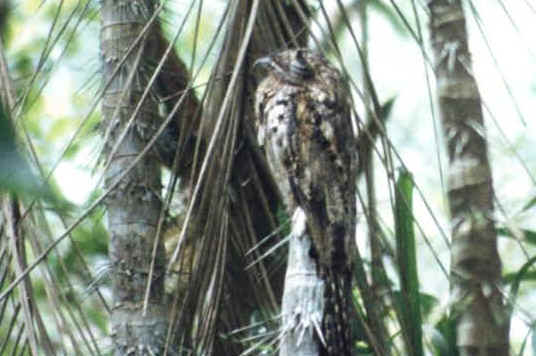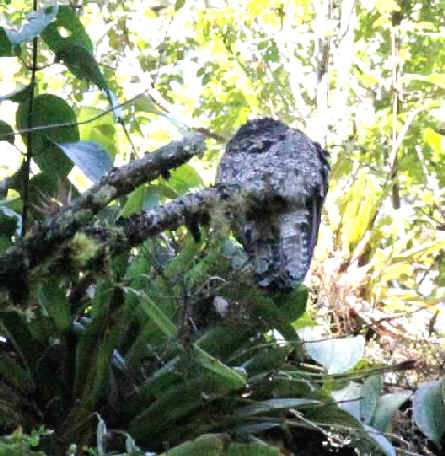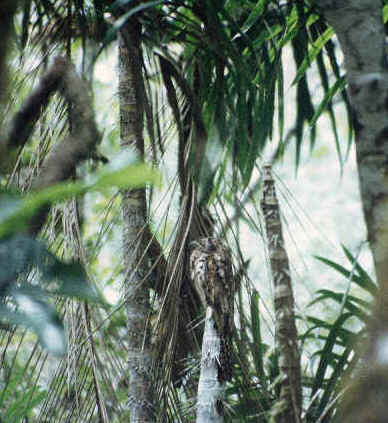 ECUADOR
BIRDS
ECUADOR
BIRDS
during Focus On Nature Tours
including tours in the
GALAPAGOS ISLANDS
Tinamous to Swifts
Noting those found during
Focus On Nature Tours
with an (*).
1991 thru 2015
during the months of February,
April, May, July, and August
Part 1 of a List of Ecuador Birds
compiled by Armas Hill,
with some photos.
There have been 21 FONT birding tours in Ecuador,
during which
over 1,100 species of birds have cumulatively been seen.
Presently 1,637 species of birds are in this 4-part list.
Photo at upper right: A LONG-TAILED POTOO roosting during the day
in the Amazonian Rainforest in eastern Ecuador
(photographed by Alan Brady during a FONT tour)
A close-up photo of this bird is in the list below (number #450)
Links to Groupings of Birds in this List:
Tinamous
Chachalacas, Guans,
Curassows Waterfowl
Seabirds Grebes
Flamingos, Ibises, Spoonbill, Stork Herons, Egrets, Bitterns Cormorants,
Anhinga
Tropicbird, Frigatebirds, Pelicans, Boobies Raptors
Trumpeter Rails, Crakes,
Allies
Shorebirds Skuas, Gulls, Terns, Skimmer
Pigeons, Doves
Macaws, Parakeets,
Parrots
Cuckoos Owls Oilbird,
Potoos Nighthawks, Nightjars
Swifts
There is relatively new information in this list regarding the taxonomy of owls, and their
vocalizations.
Links to Other Parts of
this Ecuador Bird List:
Part
2: Hummingbirds to Flycatchers Part
3: Antshrikes to Woodcreepers
Part 4: Vireos to Grosbeaks
Codes:
Indicating regions visited (as
follows):
E: FOUND EAST OF THE HIGH ANDES
az: Amazonian Ecuador (including the areas of La Selva & Sacha Lodges
along the Rio Napo)
po: Podocarpus National Park
(including the Rio Bombuscara area, near Zamora)
si: the area of "San
Isidro" near Cosanga, on the east Andean slope
W: FOUND WEST OF THE HIGH
ANDES
nm: the areas of Nono Mindo
Road and/or Mindo
po: Podocarpus National Park
(including near Loja)
H: FOUND IN THE HIGH ANDES (mostly or always).
cu: Cuenca, west into the
mountains to El Cajas
po: Podocarpus National Park
(including the Cajanuma area)
G: SEEN IN THE GALAPAGOS ISLANDS
Specific Locations:
BR: Buenaventura Reserve (Umbrellabird
Lodge)
CN: Canande Reserve (Canande Lodge)
CP: Copalinga cabins & restaurant, near Zamora in southeast
Ecuador
JR: Jorupe Reserve (Urraca Lodge)
TR: Tapichalaca Reserve (Casa Simpson)
UR: Utuana Reserve
YR: Yanacocha Reserve
These locations codes are
followed by:
c: common fc: fairly common u:
uncommon r: rare vr: very rare
(t) a globally threatened or
rare species, designated by Birdlife International
(t1): critical
(t2): endangered (t3): vulnerable
(nt): a near-threatened species
globally
(Ee): species endemic to Ecuador
(Ge): species endemic to the Galapagos
(Er): rare species in Ecuador
(Ei): introduced species in Ecuador
(ph): species with a photo in the FONT website
A primary reference for this list has been the "The Birds of Ecuador - Status, Distribution, and
Taxonomy"
by Robert S. Ridgely and Paul J. Greenfield, published in 2001.
More than 2,100 birds
that have been found during FONT South America Birding Tours, in Argentina,
Brazil, Chile, Ecuador, & Venezuela.
Additional Links:
Birds of the
Amazonian Region Rare Birds of the Andes & Patagonia
Mammals
of South America (with
some photos)
Ecuador Mammals (with some photos)
Butterflies of South America
(with
some photos) Moths
of South America (with some photos)
Tropical Plants,
including some in South America (with some photos)
A Photo Gallery of Moths and
Butterflies during FONT Ecuador Tours in 2013 & 2014
PHOTO GALLERIES OF BIRDS, BUTTERFLIES, MOTHS, MAMMALS, AND OTHER NATURE
DURING FONT ECUADOR TOURS IN: April 2013
July
2013 April/May
2014:
Information
about Upcoming FONT Tours:
by month in: 2015
2016 or: by
geographic locations worldwide
A Chronological List of
all scheduled FONT birding & nature tours
Upcoming FONT Birding &
Nature Tours in Ecuador & Brazil
Directory of Photos in this Web-site

Bird-List:
Tinamous
- Gray Tinamou (t3) (*) _____
E CP:fc
Tinamus tao
The Gray Tinamou has been classified as a near threatened
species in Ecuador.
- Black Tinamou (t3) (Er)
______
Tinamus osgoodi
A Black Tinamou was at Wildsumaco on March 5, 2013. The
species occurs more commonly to the north of Ecuador in Colombia,
but also to the south of Ecuador in Peru.
- Great Tinamou (nt) (*) _____ E,az CN:u
Tinamus major
- White-throated Tinamou (nt) _____
Tinamus guttatus
- Highland Tinamou (*) ______ E,si TR:r
Nothocercus bonapartei
- Tawny-breasted Tinamou (*) _____ E,si
TR:u YR:r
Nothocercus julius
- Little Tinamou (*) ______ W,E,az,nm BR:u CN:c CP:fc JR:u
Crypturellus soui
- Brown Tinamou _____
Crypturellus obsoletus
- Bartlett's Tinamou (*)
______ E,az
Crypturellus bartletti
- Undulated Tinamou (*) _____ E,az
Crypturellus undulatus
- Cinereous Tinamou (*) _____ E,az
Crypturellus cinerens
- Berlepsch's Tinamou _____ CR:u
Crypturellus berlepschi
The Berlepsch's Tinamou has been classified as a near-threatened
species in Ecuador.
- Variegated Tinamou (*) ______ E,az
Crypturellus variegatus
- Pale-browed Tinamou (nt) (*) _____ W JR:c
Crypturellus transfasciatus
The Pale-browed Tinamou has been classified as a near-threatened
species in Ecuador.
- Tataupa Tinamou _____
Crypturellus tataupa
- Curve-billed Tinamou (*)
______ H YR:u
Nothoprocta curvirostris
- Andean Tinamou _____ UR:fc
Nothoprocta pentlandii
CHACHALACAS, GUANS, CURASSOWS
- Speckled Chachalaca (*) (ph) _____
E,az
CP:c
Ortalis guttata
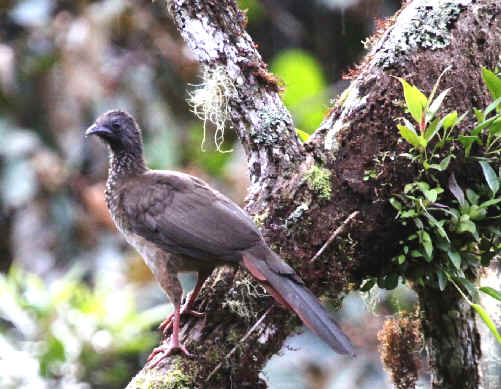
A Speckled Chachalaca photographed during the FONT tour
in southern Ecuador in April 2014
(photo by Marie Gardner)
- Rufous-headed Chachalaca (t3) (*)
(ph) _____
W BR:fc CN:r JR:fc
Ortalis erythroptera
The Rufous-headed Chachalaca has been classified as a near-threatened
species in Ecuador.
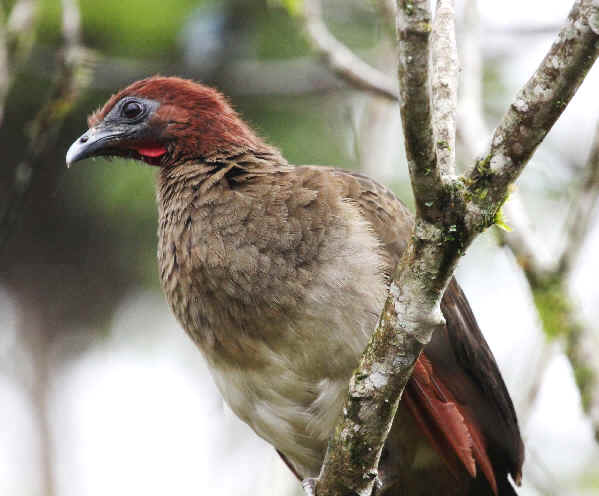
A Rufous-headed Chachalaca photographed during
the FONT tour in Ecuador in July 2013
(photo by Marie Gardner)
- Crested Guan (*) (ph) _____ W BR:u CN:u
Penelope purpurascens aequatorialis
The Crested Guan has been classified as a vulnerable species
in Ecuador.
- Bearded Guan (t3) (*) _____
W,po
TR:u
Penelope barbata
The Bearded Guan has been classified as a vulnerable species
in Ecuador.
- Spix's Guan (*) _____ E,az
Penelope jacquacu
- Andean Guan (*) _____ W,H,E,nm,si YR:u
Penelope montagnii
- Baudo Guan (t3) _____ CR:r
Penelope ortoni
The Baudo Guan has been classified as a vulnerable species
in Ecuador.
- Wattled Guan (nt) (*) _____
E,si
Aburria aburri
The Wattled Guan has been classified as a vulnerable species
in Ecuador.
- Sickle-winged Guan (*) (ph) _____
W,E,nm,si BR:u CP:u TR:u
Chamaepetes goudotii
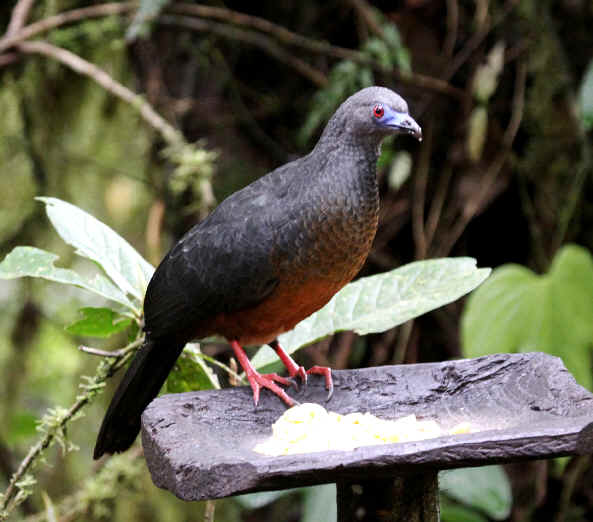
A Sickle-winged Guan photographed during the April 2013 FONT tour in
Ecuador
(photo by Marie Gardner)
- Blue-throated Piping Guan (t3) (*) _____ E,az
Pipile cumanensis
- Salvin's Curassow (*) _____
E,az
Mitu salvini
The Salvin's Curassow has been classified as a near-threatened
species in Ecuador.
- Nocturnal Curassow (*) _____ E,az
Nothocrax urumutum
- Great Curassow (t3) _____
CN:vr
Crax rubra
The Great Curassow is classified as "vulnerable" globally,
but in Ecuador it is one of the rarest and most endangered cracids in the
country, with, it is believed, less than 200 individuals remaining.
It is classified as a critically endangered species in
Ecuador.
- Wattled Curassow (t3) _____
Crax globulosa
The Wattled Curassow has been classified as a critically
endangered species in Ecuador.
- Marbled Wood Quail (nt) (*) _____ E,az,po
Odontophorus gujanensis
- Rufous-fronted Wood Quail (*) _____ W,E,si BR:fc CN:fc TR:r
Odontophorus erythrops
- Dark-backed Wood Quail (t3) (*) _____ W,nm
Odontophorus melanonotus
The Dark-backed Wood Quail has been classified as a near-threatened
species in Ecuador.
- Rufous-breasted Wood Quail (nt) (*)
(ph) _____ W,nm CP:u
Odontophorus speciosus
The Rufous-breasted Wood Quail has been classified as a near
threatened species in Ecuador.
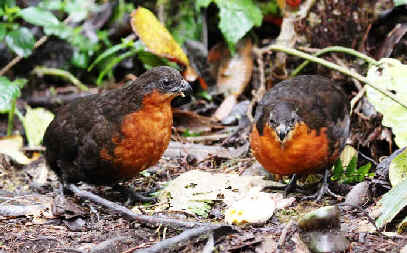
Rufous-breasted Wood Quail photographed during
the FONT Ecuador Tour in April 2013
(photo by Marie Gardner)
- Starred Wood Quail _____
Odontophorus stellatus
- Tawny-faced Quail _____ CN:u
Rhynchortyx cinctus
The Tawny-faced Quail has been classified as a near-threatened
species in Ecuador.
SCREAMER & WATERFOWL
- Horned Screamer (*) _____ W,E,az
Anhima cornuta
The Horned Screamer has been
classified as an endangered species in Ecuador.
- Fulvous Whistling Duck (*) _____
Dendrocygna bicolor
- Black-bellied Whistling
Duck (*) (ph) _____ W
Dendrocygna autumnalis
- Orinoco Goose (nt) _____
Neochen jubata
The Orinoco Goose has been classified as an endangered species
in Ecuador.
- Muscovy Duck (*) (ph) _____ E,az
Cairina moschata
The Muscovy Duck has been classified as a vulnerable species
in Ecuador.
- Andean Teal (*) _____ H,cu TR:u
Anas andium
The Andean Teal is regarded as a separate species from the Speckled
Teal, Anas flavirostris.
- White-cheeked Pintail (*) (ph) _____
G,W
Anas bahamensis rubrirostris (subspecies in Ecuador)
Another name for Anas bahamensis
has been the Bahama Pintail.
- Yellow-billed Pintail (*) (ph) _____ H
Anas georgica spinicauda (the only other subspecies is on South
Georgia Island in the South Atlantic Ocean)
- Northern Pintail (Er) (ph) ______
Anas acuta
A male Northern Pintail at Lago San Pablo in Imbabura province, on June
28, 2012, was said to be a first for Ecuador.
The species has occurred rarely in South America mostly in Colombia &
Venezuela, but also it has been said in Brazil.
- Northern Shoveler (Er) (ph)
______
Anas clypeata
On December 17, 2012, 26 Northern Shovelers were at the La
Tola Road, in Esmealdas province.
The species was also at Laguna Mica, in Antisana on February 9, 2013.
- Blue-winged Teal (*) (ph) _____ G,H
Anas d. discors
- Cinnamon Teal _____
Anas cyanoptera borreroi (a resident
subspecies in the Andes)
The Cinnamon Teal has been classified as an extirpated
species in Ecuador.
- Southern Pochard (Er) (*) _____
Netta erythrophthalma
The Southern Pochard has been classified as a critically
endangered species in Ecuador.
- Torrent Duck (*) (ph) _____
W,H,E,nm,po,si
TR:u
Merganetta armata colombiana
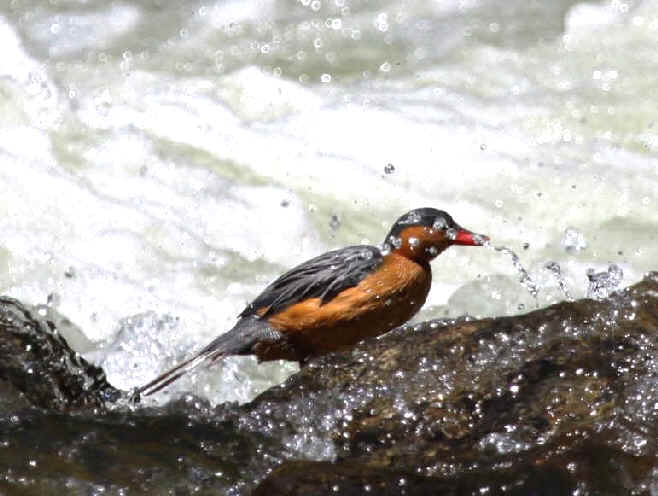
A female Torrent Duck photographed during the FONT tour
in Ecuador in April 2013
(photo by Marie Gardner)


 ECUADOR
BIRDS
ECUADOR
BIRDS




